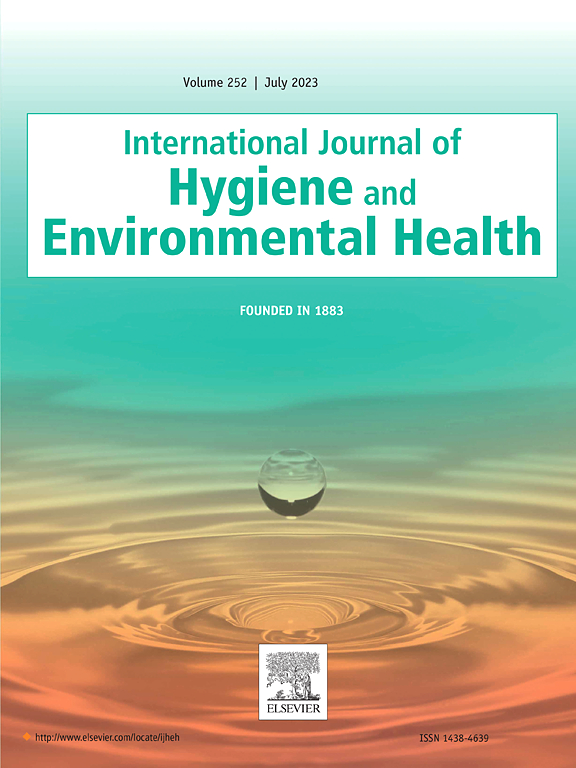Mortality risk of short-term air pollution exposure in urban and rural Chinese populations: A nationwide time-stratified case-crossover study, 2008–2020
IF 4.4
2区 医学
Q1 INFECTIOUS DISEASES
International journal of hygiene and environmental health
Pub Date : 2025-03-24
DOI:10.1016/j.ijheh.2025.114564
引用次数: 0
Abstract
Background
Epidemiologic evidence underpinning current World Health Organization Air Quality Guidelines (WHO AQGs) is primarily derived from urban populations, which remains challenging for implementing the guidelines in low- and middle-income countries (LMICs) where most people reside in rural or less developed areas. Here, we aimed to characterize the associations between ambient air pollution and mortality in Chinese populations living in both urban and rural areas, where rural populations have not been studied previously at national level.
Methods
In this nationwide time-stratified case-crossover study, we extracted non-accidental death cases of all ages in both urban and rural areas during 2008–2020 from National Mortality Surveillance System, which covered 40,300 representative township-level administration units from 29 provinces, representing nearly 24 % of Chinese population. The urban-rural classification of participants' addresses was defined based on the China's National Bureau of Statistics. Daily township-level exposures to ambient particulate matter in diameter less than 10 μm and 2.5 μm (PM10 and PM2.5), nitrogen dioxide (NO2), carbon monoxide (CO), sulfur dioxide (SO2), and 8-h maximum ozone (O3) were estimated using the Nested Air Quality Prediction Modeling System. We applied conditional logistic regression models to characterize province-specific associations of mortality risks with air pollutants, and then combined the estimates using random-effects meta-analysis.
Results
A total of 61,228,962 all-cause deaths were compiled in the analysis. During the study period, 87.3 % of the death cases had PM2.5 exposure on the same day of death above current short-term guideline level of 15 μg/m3, and 35.6 % had O3 exposure above guideline level of 100 μg/m3. In this analysis, significant morality risks were observed in associations with short-term exposures to all six criteria pollutants. In specific, each 10 μg/m3 increase in PM2.5 exposure levels on the same day of death was associated with increased mortality risks of 0.22 % (95 % confidence interval [95CI %], 0.13 to 0.31). Further, when exposure levels below the guidelines of 15 μg/m3, PM2.5 exposure attributed mortality risks increased to 1.59 % (95CI %, 0.84 to 2.35), which became largely comparable with the risks observed in high-income country studies. Notably, we derived the effects attributed to nationwide O3 exposure, with association estimate of 0.18 % (95CI %, 0.11 to 0.25), which is also comparable with global estimates. The mortality risks for major criteria pollutants PM2.5, PM10, NO2, SO2, and O3 were slightly greater among urban populations than those observed in rural populations.
Conclusion
This nationwide study for the first time showed increased and globally comparable mortality risks of PM2.5 exposure below current guideline level, as well as significant morality risks of O3 exposure, in Chinese populations of all ages from both urban and rural areas. Our timely findings highlight the importance of global implementation of AQGs and call for immediate air quality management actions, particularly in less developed areas.
中国城乡人口短期空气污染暴露的死亡风险:2008-2020年全国时间分层病例交叉研究
支持当前世界卫生组织《空气质量指南》的流行病学证据主要来自城市人口,在大多数人居住在农村或欠发达地区的低收入和中等收入国家(LMICs)实施指南仍然具有挑战性。在这里,我们的目的是描述中国城市和农村人口的环境空气污染与死亡率之间的关系,农村人口以前没有在全国范围内进行过研究。方法在这项全国时间分层病例交叉研究中,我们从全国死亡率监测系统中提取了2008-2020年期间城乡所有年龄段的非意外死亡病例,覆盖了29个省份的40,300个具有代表性的乡镇一级行政单位,占中国人口的近24%。参与者地址的城乡分类是根据中国国家统计局的数据确定的。利用巢式空气质量预测模型系统,估算了乡镇居民每日暴露于直径小于10 μm和2.5 μm的环境颗粒物(PM10和PM2.5)、二氧化氮(NO2)、一氧化碳(CO)、二氧化硫(SO2)和8小时最大臭氧(O3)。我们使用条件逻辑回归模型来表征各省特定的死亡率风险与空气污染物的关联,然后使用随机效应荟萃分析将估计结果结合起来。结果共收集全因死亡病例6128.8962例。在研究期间,87.3%的死亡病例死亡当天PM2.5暴露量高于现行短期指导水平15 μg/m3, 35.6%的死亡病例O3暴露量高于现行指导水平100 μg/m3。在本分析中,观察到与短期暴露于所有六种标准污染物有关的重大道德风险。具体而言,死亡当天PM2.5暴露水平每增加10 μg/m3,死亡风险增加0.22%(95%可信区间[95CI %], 0.13至0.31)。此外,当暴露水平低于15 μg/m3的指导值时,PM2.5暴露导致的死亡风险增加到1.59% (95CI %, 0.84至2.35),这与高收入国家研究中观察到的风险基本相当。值得注意的是,我们得出了归因于全国臭氧暴露的影响,相关估计为0.18% (95CI %, 0.11至0.25),这也与全球估计相当。主要标准污染物PM2.5、PM10、NO2、SO2和O3的死亡风险在城市人群中略高于农村人群。这项全国范围内的研究首次显示,PM2.5暴露低于当前指导水平的死亡率风险增加,全球可比较,中国城市和农村各年龄段人群的O3暴露存在显著的道德风险。我们及时的研究结果强调了全球实施空气质量指标的重要性,并呼吁立即采取空气质量管理行动,特别是在欠发达地区。
本文章由计算机程序翻译,如有差异,请以英文原文为准。
求助全文
约1分钟内获得全文
求助全文
来源期刊
CiteScore
11.50
自引率
5.00%
发文量
151
审稿时长
22 days
期刊介绍:
The International Journal of Hygiene and Environmental Health serves as a multidisciplinary forum for original reports on exposure assessment and the reactions to and consequences of human exposure to the biological, chemical, and physical environment. Research reports, short communications, reviews, scientific comments, technical notes, and editorials will be peer-reviewed before acceptance for publication. Priority will be given to articles on epidemiological aspects of environmental toxicology, health risk assessments, susceptible (sub) populations, sanitation and clean water, human biomonitoring, environmental medicine, and public health aspects of exposure-related outcomes.

 求助内容:
求助内容: 应助结果提醒方式:
应助结果提醒方式:


